Key takeaways:
- Women’s health advocacy fosters connection and validation through shared experiences, breaking stigma around health issues like postpartum depression.
- Campaign evaluation is essential for understanding audience engagement, tailoring messaging, and identifying effective outreach strategies.
- Emotional storytelling and personal narratives enhance community interest and participation, leading to more impactful advocacy efforts.
- Building strong community partnerships and maintaining open communication are crucial for empowering individuals and ensuring advocacy remains relevant.
Understanding women’s health advocacy
Women’s health advocacy is about amplifying the voices of those who have often been unheard. When I first became involved in this field, I was struck by the profound impact that a supportive community can have on an individual’s journey. Have you ever felt empowered just by sharing your story? That’s the essence of advocacy—it fosters connection and validation among women who face similar health challenges.
The landscape of women’s health advocacy is ever-evolving, shaping our understanding of critical issues like reproductive rights, mental health, and access to healthcare. During a recent campaign, I encountered powerful stories from women who bravely opened up about their experiences with postpartum depression. Their courage made me realize that sharing these realities is vital for breaking stigma. Isn’t it incredible how personal narratives can pave the way for broader societal change?
Engaging with women’s health advocacy also means recognizing the intersection of race, socioeconomic status, and geographic location. I once attended a workshop where participants brought forth their diverse experiences, highlighting disparities that still exist in accessing care. This immersion opened my eyes to the complexity of health issues. It made me question: how can we ensure that every woman, regardless of her background, has a voice in her healthcare decisions? It’s a challenge that we all must confront together.
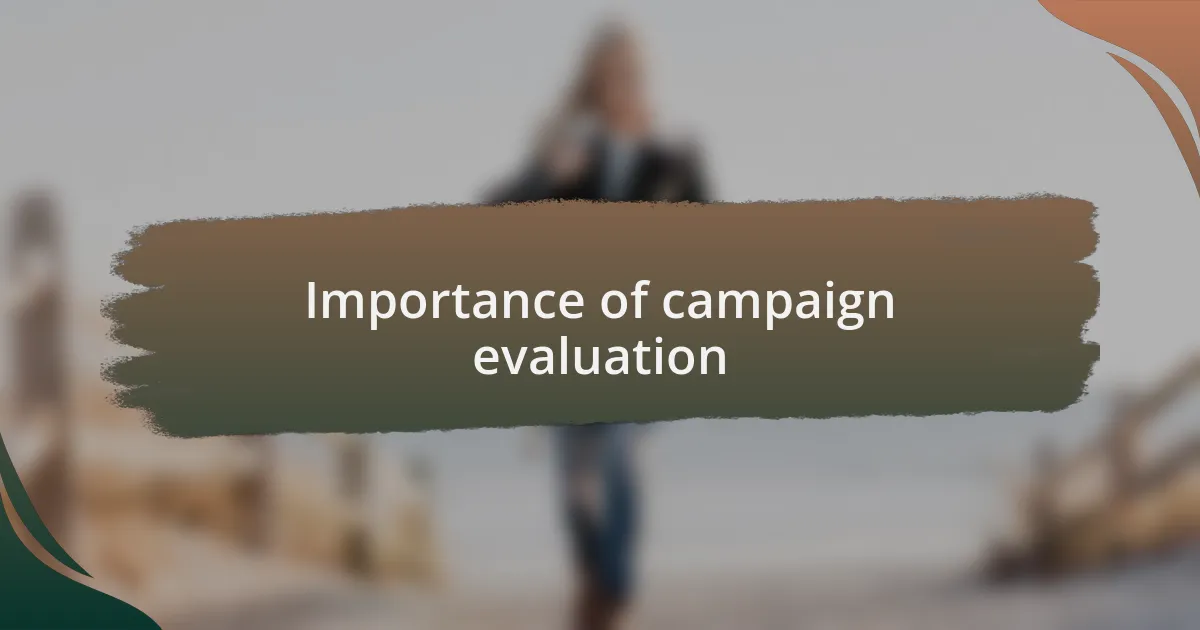
Importance of campaign evaluation
Evaluating campaigns is crucial because it helps us understand what resonates with our audience. Once, after a campaign focused on mental health awareness, I discovered that our messaging was not connecting with younger women as I had hoped. Analyzing feedback revealed that the language we used felt dated. This insight not only changed our approach but deepened my appreciation for the need to listen and adapt to our audience’s needs.
Through campaign evaluation, we can identify strengths and weaknesses that impact our objectives. Reflecting on a recent initiative regarding reproductive health, I realized that while our outreach was extensive, many women still felt alienated from the information we provided. I learned that tailoring our messages and outreach methods was essential. Have you ever felt that you could’ve done something differently after reflecting on an experience? Evaluation is like a mirror—it shows us not just our image but the unseen facets we can enhance.
Additionally, understanding the impact of our campaigns allows us to allocate resources more effectively. I once participated in a campaign where we spent a lot on advertisements, but little on community engagement events. Evaluating the outcomes showed that personal interactions made a more lasting impression. Isn’t it fascinating how sometimes the simplest efforts can yield the most significant results? By reassessing our strategies and priorities, we can create campaigns that truly make a difference in women’s health advocacy.
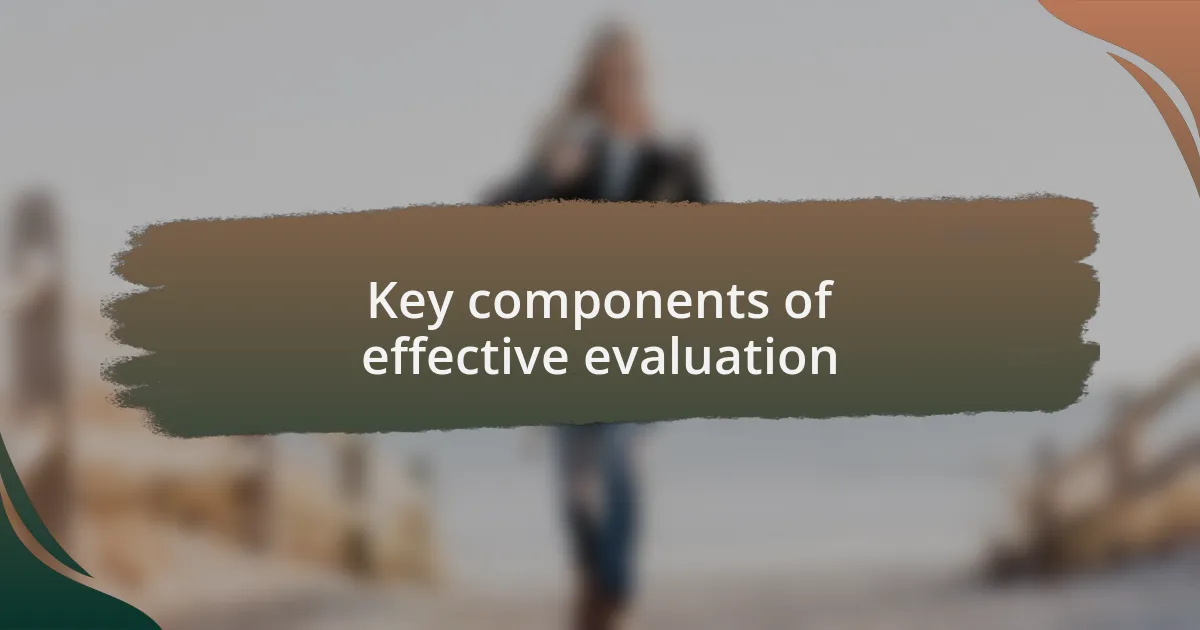
Key components of effective evaluation
Effective evaluation hinges on clear objectives and measurable outcomes. I recall a time when we launched a campaign aimed at increasing awareness of cervical cancer screening. Initially, our goals were somewhat vague, leading to challenges in measuring success. It was only after we set specific targets—like aiming for a 20% increase in screening appointments—that we could assess our effectiveness. This focus led to targeted adjustments, enriching the campaign’s impact.
Another critical component is stakeholder feedback. During a previous project advocating for maternal health awareness, I actively sought input from both healthcare providers and women in the community. Their diverse perspectives revealed gaps in our messaging that I had overlooked. Isn’t it amazing how multiple viewpoints can illuminate paths we didn’t even consider? By involving stakeholders in the evaluation process, I not only strengthened our campaign but also fostered a sense of ownership within the community.
Lastly, utilizing data effectively can transform evaluations into actionable insights. In one initiative, we tracked social media engagement metrics but initially failed to link them to real-world actions, like health screenings reported by clinics. By correlating those numbers with actual participation rates, I gained a clearer picture of our campaign’s impact. Have you ever pieced together data to unveil a bigger narrative? That experience reinforced for me the power of data-driven evaluation in shaping future advocacy efforts.
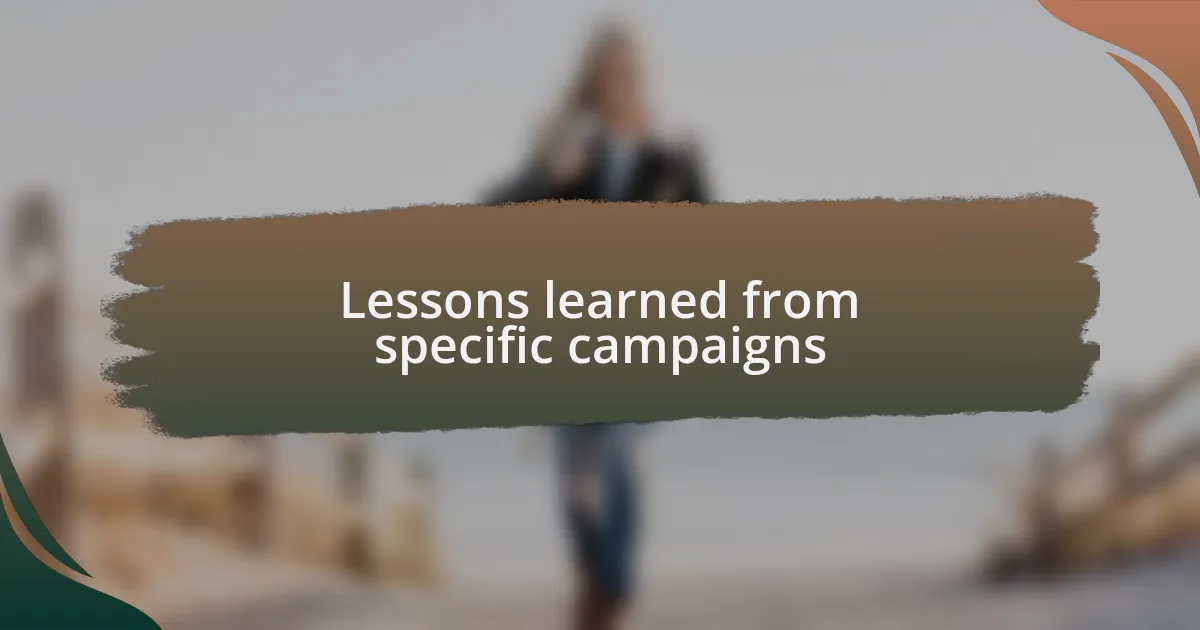
Lessons learned from specific campaigns
One powerful lesson I learned from a campaign focused on mental health awareness was the importance of emotional storytelling. We initially relied on statistics and facts to engage our audience, but it wasn’t until we shared real-life stories that we witnessed a noticeable uptick in community interest and participation. Engaging stories can genuinely resonate with people; they challenge them to reflect on their own experiences and connect on a personal level. Have you ever found that a story moved you more than just cold hard facts?
Another enlightening experience came from our campaign aimed at combating domestic violence. We assumed that having comprehensive resources readily available would be enough to drive action. Surprisingly, the response was tepid at best. By revisiting our outreach methods and creating more direct channels for individuals to seek help confidentially, we learned that accessibility is about more than just information—it’s about creating a safe space for those in need. It’s often those small adjustments that lead to monumental shifts.
Finally, I was involved in a teens’ reproductive health initiative that taught me about the value of adaptability. We launched the campaign with specific messaging tailored for young audiences, but it quickly became clear that social media was their preferred platform for engagement. By pivoting our approach and creating interactive content, we not only increased our outreach but also empowered teens to take charge of their health conversations. Isn’t it interesting how flexibility can open doors to previously inaccessible audiences? This experience underscored how staying responsive can significantly enhance the effectiveness of our advocacy efforts.
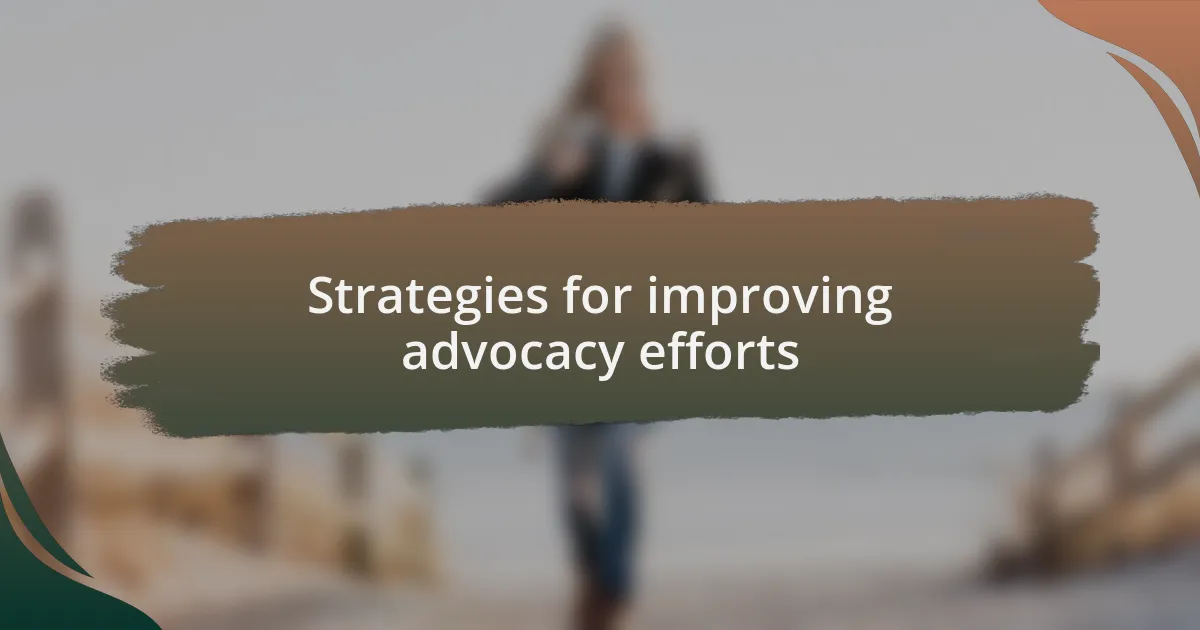
Strategies for improving advocacy efforts
One of the most effective strategies I’ve discovered for improving advocacy efforts is building strong community partnerships. In one campaign, we collaborated with local organizations that already had the trust of the community. This not only expanded our reach but also lent credibility to our message. Have you ever noticed how a familiar voice can make you pay attention more? The right collaborations can amplify your impact, making it essential to forge connections that resonate on a community level.
In another instance, we focused on training advocates from within the community. By empowering individuals to share their own stories and take the lead in discussions, we witnessed a powerful shift in engagement. I can still recall the moment a participant expressed how sharing her journey helped her reclaim her voice—it was transformative for everyone involved. When advocates see themselves as part of the solution, the momentum for change can build exponentially. Don’t you think empowering individuals fosters a deeper commitment to the cause?
Additionally, maintaining open lines of communication is crucial. I remember a particularly challenging campaign where feedback loops were overlooked. When we finally integrated community input into our strategy, the changes proposed were eye-opening. It reminded me that advocacy isn’t a monologue; it thrives on dialogue. How can we effectively advocate without truly listening to the needs of those we serve? Prioritizing this communication not only enhances trust but ensures our efforts remain relevant and impactful.
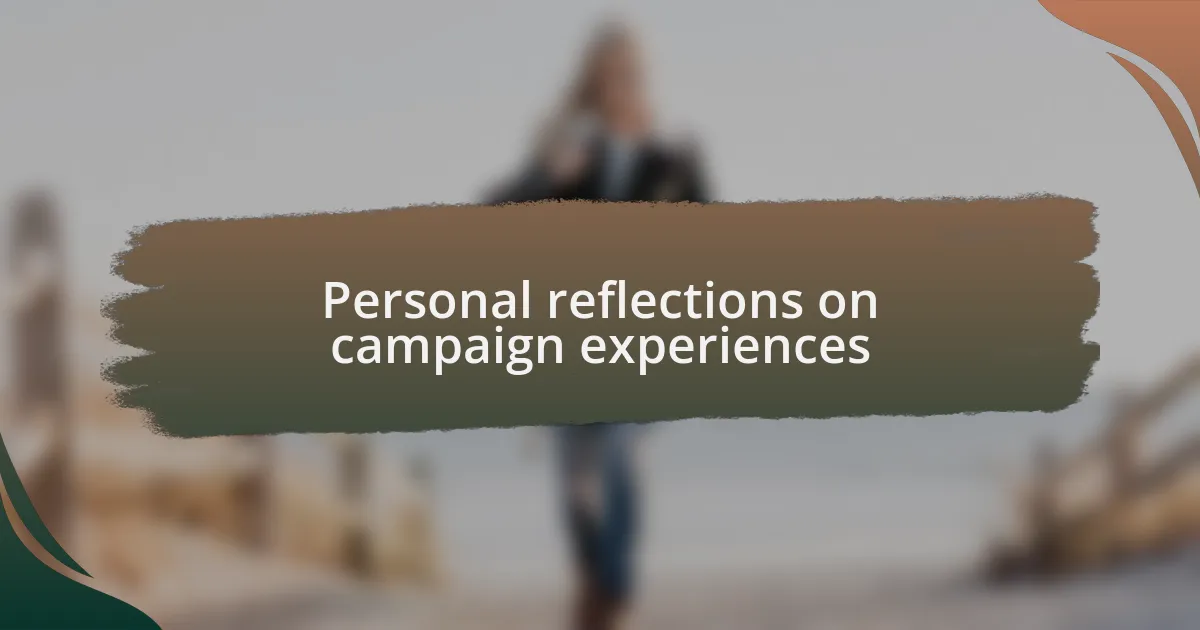
Personal reflections on campaign experiences
Reflecting on my campaign experiences, one moment stands out vividly. During a workshop, I witnessed a participant dismantle her fears about public speaking. It struck me how deeply personal narratives can resonate when shared in a safe space. That day, I learned the importance of creating an environment where vulnerability is welcomed—after all, isn’t it our authentic selves that can inspire real change?
Another experience that shaped my perspective was a community event I organized. As the day unfolded, I felt an overwhelming sense of connection among the attendees. There was laughter, tears, and a shared understanding that transcended our individual struggles. I realize now that it’s those emotional connections that fuel our advocacy efforts. Have you ever felt the unifying power of shared experiences? It can transform a campaign from a mere project into a collective movement for change.
Then there was a moment of deep humility when a community leader approached me after a campaign presentation. She thanked me for including her insights and emphasized how much it meant to be heard. It reminded me that advocacy isn’t just about the message—it’s about amplifying voices that often go unheard. I often ask myself: how can we ensure everyone’s voice is part of the conversation? Each interaction has reaffirmed my belief that advocacy must prioritize inclusivity and respect for diverse perspectives.